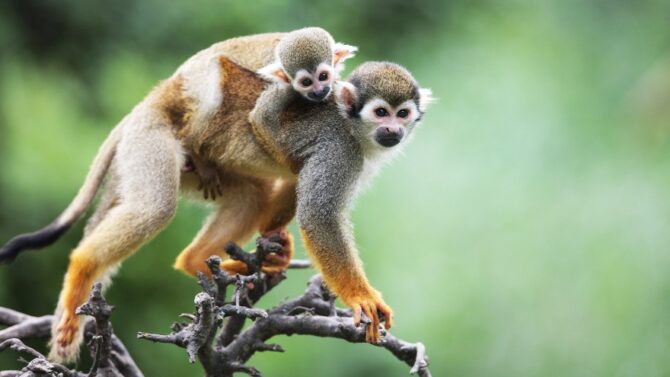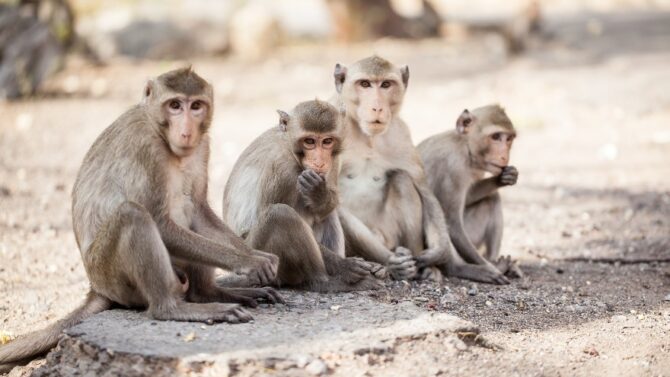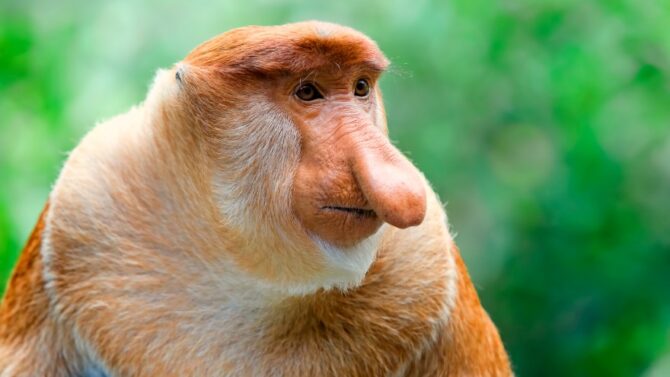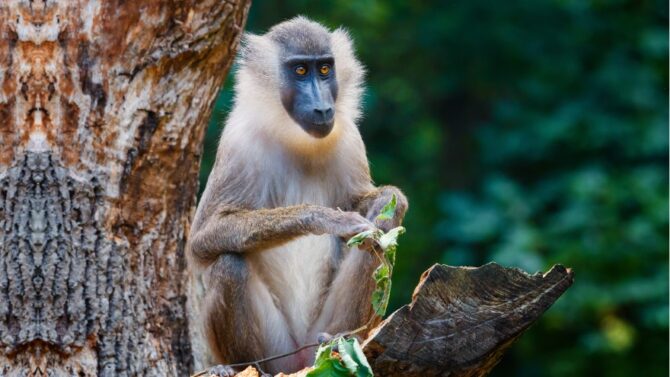Many species are termed monkeys, and they come in different shapes and sizes.
Overall, monkeys are smaller than apes as they are usually arboreal and need to be lightweight to swing from a tree.
Of course, some old-world monkeys are big, but among primates, they often are the small ones. Our focus here is on the smallest primates, ranked from the smallest downward.
The world’s smallest monkeys include the pygmy marmoset, night monkey, squirrel monkey, silvery marmoset, and cotton-top tamarin, among others.
Read on to find out how big these small monkeys are and other interesting facts you should know about them.
What are the Smallest Monkeys in the World?
1. Pygmy Marmoset
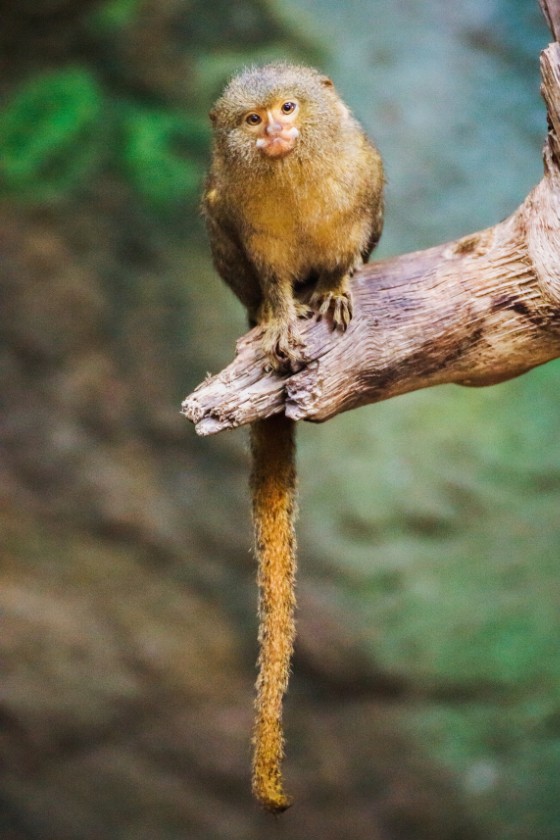
- Scientific Name: Cebuella
- Length: 4.6 to 6.0 inches
- Weight: 3.5 ounces
- Identifying Features: Brownish gold, grey and black colors, long tail
- Where Found: South America
- Conservation Status: Not Extinct
The pygmy marmoset is the world’s smallest monkey, capable of fitting into an adult human’s palm. This explains why it is called a pygmy.
The pygmy marmoset makes up the genus Cebuella, and there are two species in existence. These are the western pygmy marmoset and the eastern pygmy marmoset.
Despite being small, this monkey has a long tail, which is even longer than the rest of its body.
The tail isn’t prehensile in that it doesn’t help it grab at objects. However, it plays a role in balance as the monkey climbs.
Other physical traits of the pygmy marmoset include a mix of brownish gold and grey and brown colors. There are also black rings on the tail and some white color on the face.
The pygmy marmoset moves in troops of 2 to 9 individuals, including the dominant male and breeding female. This monkey can be a pet, but due to the challenges, it is not for everyone.
2. Roosmalens’ Dwarf Marmoset
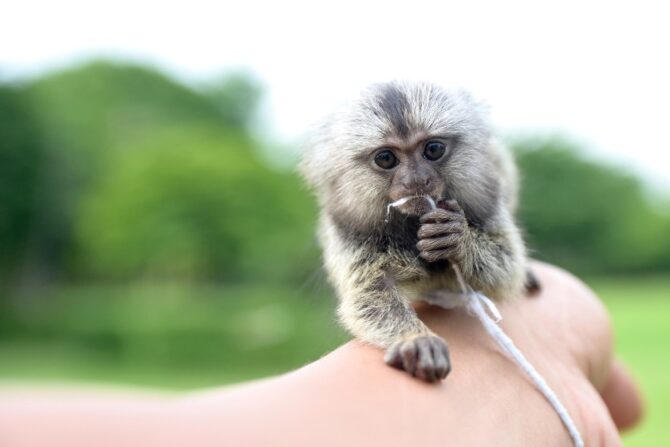
- Scientific Name: Mico Humilis
- Length: 15 to 15.5 inches
- Weight: 5.5 to 6 ounces
- Identifying Features: dark olive-brown upper parts, pale pinkish face
- Where Found: Amazon Rainforest
- Conservation Status: Least Concern
The Roosmalens’ dwarf marmoset is a New World Monkey that can be found in the Amazon rainforest, and it can also be called the black-crowned dwarf marmoset.
Only the pygmy marmoset is smaller than Roosmalens, which justifies the “dwarf” in the name. The first description of this monkey was in 1998.
The upper parts of the Roosmalens’ dwarf marmoset is an olive green, and the lower areas are colored a dull yellow.
Its face is pale and pinkish, while the hair is white and the crown black. Rather than nails that marmosets have, the Roosmalens come with claws.
3. Silvery Marmoset
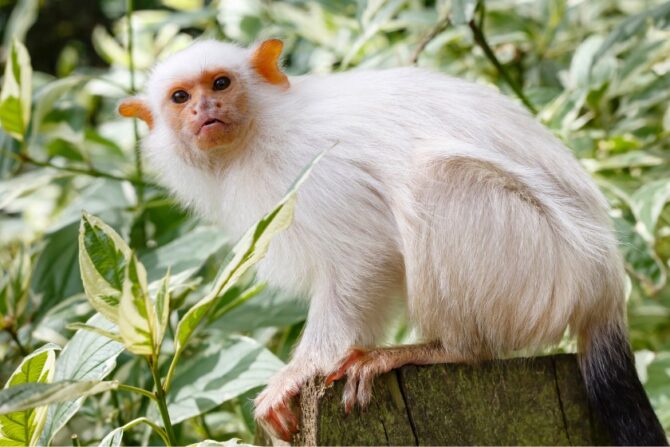
- Scientific Name: Mico argentatus
- Length: 7.1 to 11 inches
- Weight: 11 to 14 ounces
- Identifying Features: silver fur, dark tail
- Where Found: Amazon Rainforest
- Conservation Status: Least Concern
Best recognized by its silver fur, the silvery marmoset is the third smallest monkey in the world.
It lives more in the Amazon rainforest, though its range has expanded due to plantations. Like the aforementioned species, the silvery marmoset is a New World Monkey.
Not all parts of the silvery marmoset are silver. Its tail is dark, and its ears have a fleshly color.
Some individuals even have brown fur. On a tree, the silvery marmoset can resemble a squirrel because of its size and color.
These creatures live in small communities. They are both diurnal and arboreal, living in areas with trees.
As an omnivore, their diet includes tree saps, bird eggs, insects, and fruits.
4. Common Marmoset

- Scientific Name: Callithrix jacchus
- Length: 7.28 to 7.4 inches
- Weight: 8.32 to 9.03 ounces
- Identifying Features: Multicolored fur, banded tail
- Where Found: Brazil
- Conservation Status: Least Concern
The common marmoset is found in the northeastern sides of Brazil, specifically in states like Bahia, Piaui, Paraiba, and Rio Grande do Norte.
It has currently extended to the southern parts of Brazil, but it can hardly be found in any place outside of Brazil. It is a small monkey with a maximum weight reaching 9 ounces.
The fur is colorful, combining brown, grey, and yellow to achieve a multicolored masterpiece.
Its tail is banded, the nails are like claws, and the ear tufts are colored white. Overall, the common marmoset is striking, despite its small looks.
5. Graells’s Tamarin

- Scientific Name: Leontecobus nigricollis graellsi
- Length: 7.8 to 12 inches
- Weight: 7.9 to 32 ounces
- Identifying Features: Olive brown back
- Where Found: South America
- Conservation Status: Near Threatened
The Graells’s tamarin is a subspecies of the black-mantled tamarin. Though it differs from other black-mantled tamarins, the Graells’s tamarin can’t be considered a separate species.
The fur is colored black or dark brown, and it is silky to the touch. It is also quite long, covering the body.
Besides the thumb that has a nail, the Graells’s tamarin comes with claws on the fingers.
These animals are monogamous, and only the dominant pair are allowed to reproduce.
6. Cotton-top Tamarin

- Scientific Name: Saguinus Oedipus
- Length: 8.2 to 10.2 inches
- Weight: 15.2 ounces
- Identifying Features: White crest, black face, white bands
- Where Found: Colombia
- Conservation Status: Critically Endangered
The cotton-top tamarin is one of the smallest primates in the world, weighing around 15 ounces.
Its name stems from the white hair at the top of its head. It lives in the forests of Columbia, which has suffered from deforestation.
This has led to a decline in the cotton-top tamarin population. There are around 6,000 left.
When you do see one, it is easy to recognize. Its crest is similar to that of a gorilla, white and extending to the shoulders.
The face is black and could be bare, hairy, or mottled, depending on the species. It is arboreal, diurnal, and omnivorous. Its diet includes insects and plants.
7. Night Monkey

- Scientific Name: Aotus
- Length: 9.5 to 18 inches
- Weight: 1 to 2.8 pounds
- Identifying Features: Brown fur, large brown eyes
- Where Found: South America
- Conservation Status: Not extinct
As the name shows, the night monkey is nocturnal. This is unlike many other diurnal species.
It is found in some South American countries like Panama and Argentina. Its uniqueness lies in the eyes that make seeing at night possible.
The night monkey forms a genus with species like the gray-bellied night monkey, the Panamanian night monkey, and the Azara night monkey.
One of the first noticeable traits of the night monkey is its large, brown eyes. These eyes are complemented by brown fur.
Another obvious trait is the seeming lack of ears which earned the night monkey its genus name Aotus (earless). Males and females are similar, but male is slightly taller.
8. Squirrel Monkey
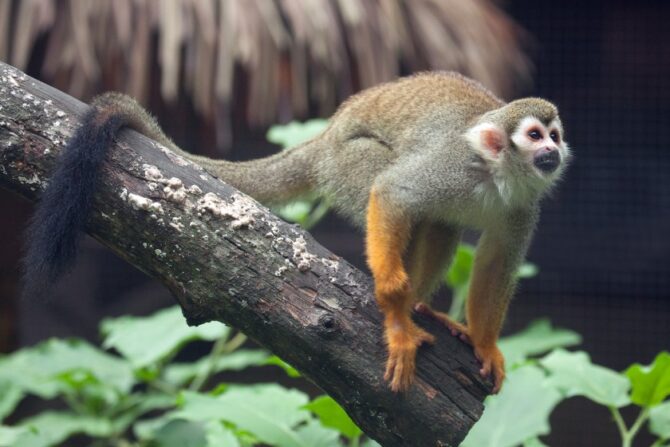
- Scientific Name: Saimiri
- Length: 9.8 to 13.8 inches
- Weight: 18 to 39 ounces
- Identifying Features: Dense fur, white patches over eyes
- Where Found: Central and South America
- Conservation Status: Not extinct
The squirrel monkey comprises the genus Saimiri, which translates in English as “small monkey.”
The genus is divided into two groups, and in total, there are five recognized species.
These species include the common squirrel monkey, the Guianian squirrel monkey, and the Collins squirrel monkey.
The squirrel monkey is described as having short fur. The shoulders are colored black, but the back and some edges are yellowish-orange.
The tails are hairy, the claws pointed, and flat nails. Added to this is the black-and-white face. Squirrel monkeys are both diurnal and arboreal, but their tails can’t latch on to trees.
9. Dusky Titi Monkey

- Scientific Name: Plecturocebus moloch
- Length: 11 to 15 inches
- Weight: 1.54 to 2.65 pounds
- Identifying Features: Red belly, round head, soft coat
- Where Found: Brazil
- Conservation Status: Least Concern
The dusky titi monkey is also known as the red-bellied titi, and it can only be found in Brazil. Its population is enough to be classified as Least Concern, but the range is narrow.
The dusky titi is known to be vocal, and some individuals look like puppies from afar.
Dusky titis have long tails, far longer than the length of their bodies. They are also known for their soft coat and hunched posture, with the tail staying down.
Compared to other monkeys, the dusky titi is considered slow. However, it can go fast when it needs to.
10. Talapoin Monkey

- Scientific Name: Miopithecus
- Length: 10 to 16 inches
- Weight: 1.76 to 4.19 pounds
- Identifying Features: yellowish green fur, long tail
- Where Found: Central Africa
- Conservation Status: Not Extinct
The Talapoin refers to the two species under the Miopithecus genus. These species are the Angolan and Gabon Talapoins.
This is the only old-world monkey on the list and the smallest in Africa. You’d find them in countries like Cameroon to Angola down to the Democratic Republic of the Congo.
The Talapoin has grey fur at the upper parts and white underneath it. The head is round, and the face is void of hair.
Completing the looks is a short snout. These monkeys can swim well and often hunt both on land and in water.
Wrap Up
There you have it! These are the 10 smallest monkeys, ranging from the tiniest (pygmy marmoset) to the only old-world monkey on the list (Talapoin).
While none of these monkeys make ideal pets, it will be a pleasure to view them in their natural habitat.
These small primates have adapted to survival in the wild, and they have their roles to play.
Next up…
- How Long Do Monkeys Live? – Discover monkey lifespan, growth, and aging.
- What Do Monkeys Eat? – Discover the wide-ranging diet of monkeys.
- Red Butt Monkeys – Here are the monkeys with a red bottom.


